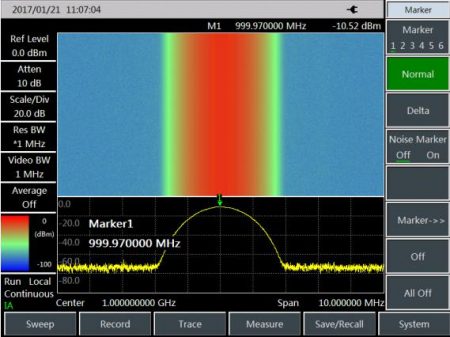The difference between oscilloscopes and spectrum analyzers is a frequently asked question for those who are just starting to touch the measuring instruments. Saluki in this article will try to give a most straightforward explanation.
Definition
Let’s first see the definition of the 2 instruments, we made minor changes based on description on Wikipedia:
A spectrum analyzer measures the magnitude of an input signal versus frequency.
Keyword: Magnitude vs Frequency
An Oscilloscope measures the magnitude of an electrical signal versus time.
Keyword: Magnitude vs Time
Thus, spectrum analyzers and oscilloscopes are instruments that measure electrical signals. The main measurement object is the amplitude of the signal, amplitude information will be displayed on the vertical axis of the 2 instruments (Note 1). The difference between the two is that the horizontal axis is different, frequency is the horizontal axis of spectrum analyzer, and the oscilloscope takes the time as the horizontal axis. In other words, the spectrum is used to observe the signal in the frequency domain and the oscilloscope user to observe the signal in the time domain.
(Note 1: The current instrument measurement capabilities are not limited to amplitude, but for ease of understanding, this article only discusses the magnitude)
Difference
The measured signal is a mixed signal of three sine wave with different frequencies. What can be observed from the oscilloscope is the actual waveform after the three signals are mixed. But it is not intuitive to know what the components of signal. From the spectrum analyzer, user can intuitively see 3 vertical lines represent the 3 frequency components, but can not see the specific input waveform.
When do we need a spectrum analyzer? Why?
The traditional observation of electrical signals is on an oscilloscope in the time domain. However, not all characteristics are fully characterized in the time domain. Circuit components, such as amplifiers, oscillators, mixers, tuners, detectors and filters, frequency characters are much more important. For these measurements, what users really need is a spectrum analyzer.
In practice, the spectrum analyzer can be very useful in tests on the remote control, walkie-talkies, measuring transmitters and receivers, cordless phones, CATV and other wired and wireless systems. Spectrum analyzers can be widely used in such equipment development, production, testing, maintenance.
FFT Oscilloscope and Spectrum Analyzer with time domain info
Most current digital oscilloscopes are equipped with FFT functions that convert time-domain signals to frequency-domain displays via FFT calculations. This is also the basic principle of some FFT spectrum analyzer. However, limited by the oscilloscope’s own processing ability and bandwidth limitations, most oscilloscope can only analyze a low frequency and the speed is slow.
Some spectrum analyzers also provide functions like waterfall, spectrogram and other features that allow the user to observe the signal over time. However, this is not the same thing oscilloscope displays. The time information displayed by waterfall or spectrogram is more used for interference analysis, etc. to observe the signal burst and changes in the tested frequency band. Saluki Spectrum Analyzer comes standard with spectrogram capabilities.

Spectrogram Function fo Spectrum Analyzer (Screenshot from S3302)



